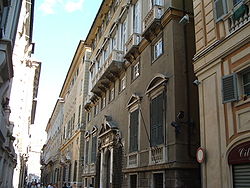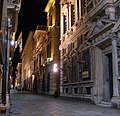Strada Maggiore o Strada Nuova | |
 View of Palazzo Rosso, one of the palaces of Via Garibaldi | |
| Alternative name | Via Aurea, Via Garibaldi |
|---|---|
| Location | Genoa, Italy |
| Region | Liguria |
| Coordinates | 44°24′40″N8°55′58″E / 44.41111°N 8.93278°E |
| Official name | Palazzi dei Rolli and Strade Nuove del Centro Storico |
| Type | Cultural |
| Region | Italy |
Via Giuseppe Garibaldi is a street in the historical centre of Genoa, in Northwestern Italy, well known for its ancient palaces. It is one of the Strade Nuove (Italian for "new streets") built by the Genoese aristocracy during the Renaissance. Since July 2006 it is inscribed in the list of UNESCO World Heritage Site Genoa: the Strade Nuove and the system of the Palazzi dei Rolli. [1]


















